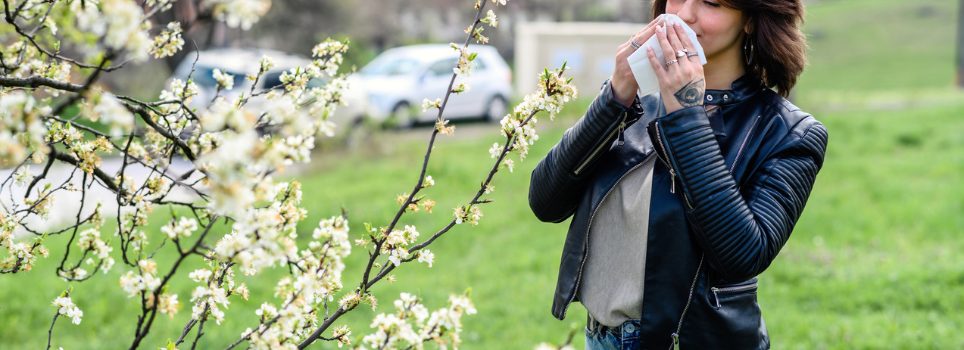The arrival of spring – and its varying temperatures – brings the first seasonal allergies.
What Is Allergy?
When we talk about allergy, we refer to an abnormal reaction of the immune system that begins to produce antibodies against some substances considered harmful to the body even though they are harmless. Allergies can affect both organs and tissues – particularly the lower airways, the skin, the mucous membranes of the nose, and the eyes.
When the body comes into contact with a substance, and antibodies detect allergens, it causes an immune reaction. The body releases chemical mediators, such as histamine, causing allergy symptoms ranging from mild irritation to anaphylaxis, a severe allergic reaction that can be life-threatening.
The Causes of Allergy
Allergies occur when the immune system responds with excessive antibody production against allergens that are harmless to most people. Allergens can be found in the air – such as pollen, animal dander, dust mites, and mold – in different types of foods – especially eggs, milk, fish, shellfish, peanuts, tree nuts, wheat, and soybeans – in medications, but also in the serum released from insect stings such as bees or wasps, and other potentially irritating substances such as latex and nickel.
Allergy and Environments
Those who suffer from pollen allergy and, therefore, spend more time indoors than in past years and wear a mask outdoors – which acts as a filter to protect the respiratory tract – may suffer less from spring allergy-related ailments.
Seasonal allergy depends significantly on the environment. Staying outdoors during pollen season may be difficult for many people. However, some allergens are also found inside the house and in closed and crowded places, such as gyms or clubs.
The places where we spend the most time often help identify the causes of allergies. For those who spend more time indoors than outdoors, dust mites, and cat and dog hair could cause some issues. Similarly, children living on the first or second floor may be more likely to develop asthma and allergies due to pollution.
What to Do to Limit Allergy Symptoms
Some habits can help alleviate the symptoms of allergies. Let’s take a look at them.
Indoors:
- Keep windows closed during the middle hours of the day, and let the house air out in the early morning or late evening when there is a lower concentration of pollen in the air.
- Use the dehumidifier to dry the shower walls so mold does not form.
- Wash carpets, curtains, and floors frequently.
- Change bedding frequently.
- Use specific mite-proof covers for pillows and mattresses. Also, avoid materials that attract dust, preferring vinyl, wood, metal, and leather when purchasing furniture.
- Wash pets once a week to remove allergens in their fur.
- Do not use a vacuum cleaner if it does not come with specific filters.
- Avoid contact with carpets, rugs, upholstery, and soft toys if possible.
In the office:
- Air the office out upon arrival and then avoid opening the windows during the rest of the day.
- Avoid contact with plants and flowers.
- Make sure the office is clean to prevent dust mite allergies.
Outdoors:
- Avoid places such as parks and gardens, which have high pollen concentrations. Choose seaside and mountain locations whenever possible.
- Avoid going out in the middle or hottest hours of the day when pollen concentration is higher.
- Similarly, avoid the first moments of a thunderstorm, when rain facilitates the release of pollen allergens.
- Try breathing through the nose, which, as opposed to the mouth, can retain some of the allergens.
- Check information calendars about pollen presence so you know at which times of the year to be most careful.
- If using a bicycle or scooter, use a face mask and sunglasses, possibly of the wrap-around type.
- In cars, use the pollen filter, if present, and avoid keeping windows open.
What to Do When the Allergy Sets In?
Those who suffer from allergies will need therapy tailored to their case. There are four types of solutions depending on the patient and the type of allergy:
- Topical antihistamines and antiallergics are suitable for relieving allergic rhinitis and conjunctivitis that appear seasonally. They are both sprays and eye drops.
- Topical corticosteroids are also suitable for the treatment of seasonal allergic rhinitis.
- Oral antihistamines are helpful for the treatment of allergic symptoms such as itching, allergic-type rhinitis, and conjunctivitis presenting with rhinorrhea, nasal or ocular itching, sneezing, and tearing.
- Specific immunotherapy, or the so-called “vaccine” for allergies, is the only therapy that can interfere with the immunological mechanisms underlying allergy and should be considered the most critical elective therapy for those with allergies.
However, those who suffer from allergies should carry medications with them, i.e., oral-type antihistamines or topical anti-allergy sprays for the nasal passages, which promote decongestion in the case of hay fever outside the home. Lastly, it is essential to use antihistamines moderately and for limited periods.
-
3,400 Physicians
-
110,400 Annual surgeries
-
190,400 Annual Inpatient Admissions
-
928,000 Patients


